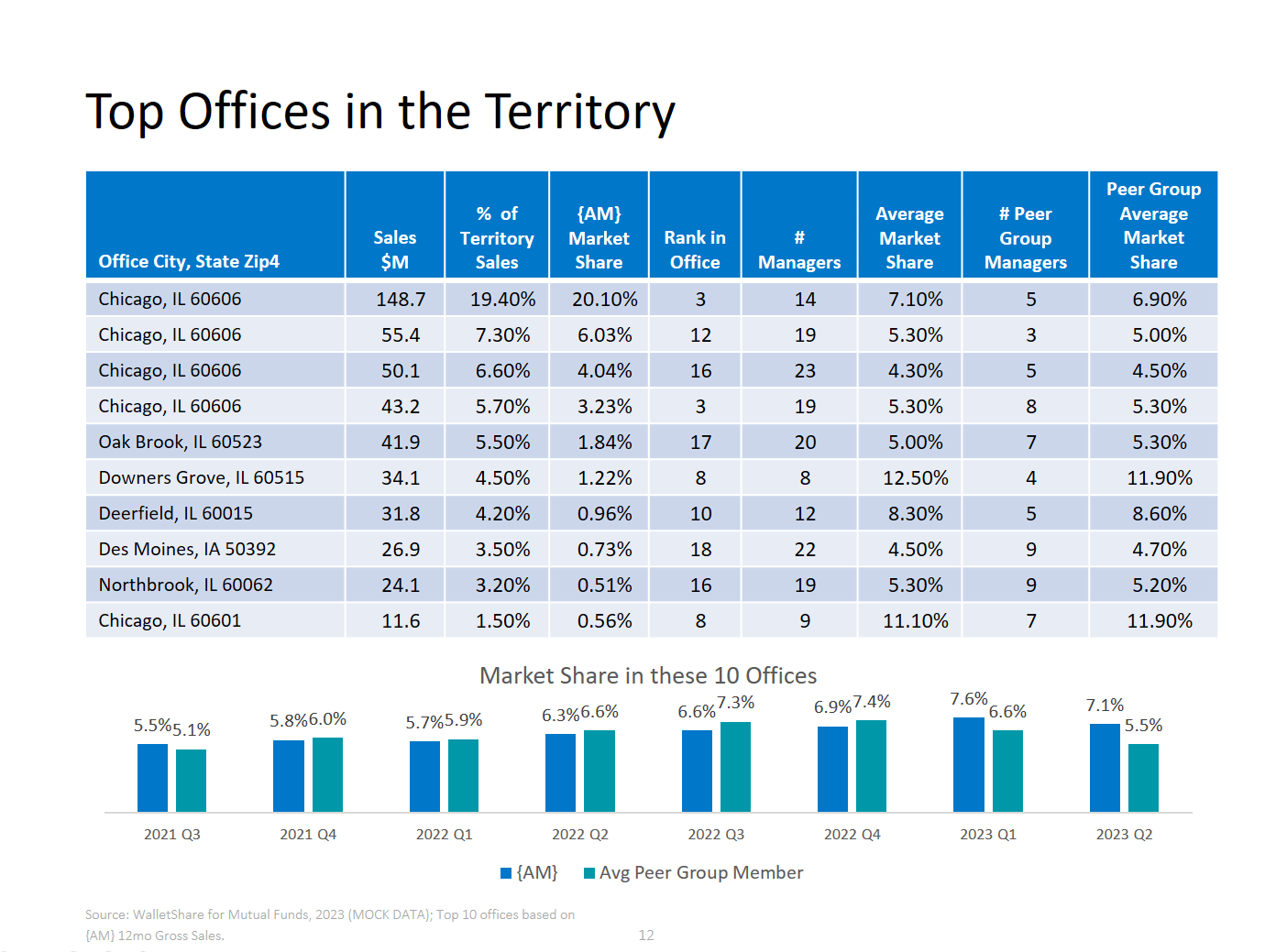BLOG. 3 min read
Is Selling Mutual Funds Really a Relationship Business?
January 4, 2024 by Jason Dauwen
Put two or more sales managers in a room for more than 10 minutes and one will say, "At the end of the day, this is a relationship business." Some might view that phrase to mean, "Every business is a relationship business." But what if a client asks for an analysis showing the concentrations of sales at the top five offices in each of their sales territories? What would that stat tell you about your business? Mutual funds sales concentration is higher than most industries. One study, "Industry Top Offices for Mutual Funds," showed that mutual funds sales don’t quite fit the 80/20 rule—it’s more like an 80/10 rule (80% of sales from just 10% of offices). But, how concentrated could sales possibly be at just five offices in a territory?
Then the data in our example comes back. Some territories, it turns out, get north of 50% of sales from just five offices. More broadly, it is quite common for more than a third of territory sales to come from just ten big buying units. This begs the question, "What would happen if they lost just one of those big relationships?" One relationship, out of hundreds managed by a sales team, could dramatically change the outcomes for an entire sales territory. This is a relationship business.
While this is eye-opening and interesting, it immediately presents so many questions—questions that are incredibly important to consider:
- Do these top buyers really represent the best possible relationships? Sure, they generate a lot of revenue, but if the same resources were applied to different relationships with similar books of business but with better alignment to the firm’s best products, would that improve overall production in that territory?
- Could rationalizing hundreds of offices, which collectively account for a tiny sliver of revenue, and refocusing those sales resources to provide more robust service to 50 or 100 big buyers that better align with the firm’s offerings improve overall production in the territory?
- Contrarily, what happens if the sales team loses one or more of these big, important relationships? In current market conditions, what would a loss of 5-10% of sales in a big territory mean to your firm’s financial health? What is the replacement cost to shore up that loss? And how long would it take to rebuild that revenue stream?
- How many of a firm’s territories are this heavily concentrated? Is it all of them? And if so, how much risk does that present to your market share?
- How much breadth is involved in achieving this big sales pull? Are you selling your full suite of products to get to that huge sales number? Or are the sales as heavily concentrated in a few products?
- Are all of these big advisors at distributors you see as strong, long-term partners?
- Is there a way to reap the benefits of such big relationships while mitigating the risk of being so heavily concentrated?
How do you mitigate the risks associated with highly concentrated sales while staying competitive? The short answer is through a balance of depth and breadth. This allows you to sell much of your product line to a broad array of advisors. You have to be able to identify where to put your focus. Replace the relationships before you lose them by building a pipeline that can dilute the concentration of sales in each of your territories. But, salespeople can only maintain a certain number of high-touch relationships. The only way to effectively do that is to understand your numbers.
You need to leverage the data available to you to understand which relationships are your best long-term opportunities. This will help you understand which relationships are your up-and-comers and rationalize relationships that prevent you from focusing on these important advisors. For example, knowing which advisors in the territory are most similar to your top relationships and knowing how to focus adequate attention on them will generate lift.
Additionally, leveraging data will help you see when you have overlooked prospects with better alignment than the ones you currently focus on. Knowing how sticky your assets are at each relationship in the territory can help you prioritize long-term benefits (longer holding periods) over short-term benefits (increased sales revenue). Would this help you to, say, have a better understanding of where to pitch value add programs? Having territory-level analyses that can help identify these relationships is a benefit few asset managers are leveraging today.
SS&C can help you with customized, highly focused territory dashboards that will provide you scorecards to highlight where each territory is over- or under-performing, as well as a deeper look at each of your firm’s territories with intuitive charts that easily compare performance over time, to peers and competitors.

Figure 1: Territory Top Offices view showing concentration at top 10 branches (based on Mock Data).
Being able to understand what data is available, how it can be used and how it can benefit your sales organization is just a phone call away. Reach out to SS&C to get the conversation started around custom reports and dashboards to help you make data-enabled decisions to strike the right balance in your sales strategy.
Written by Jason Dauwen
Sr. Business Research Analyst






